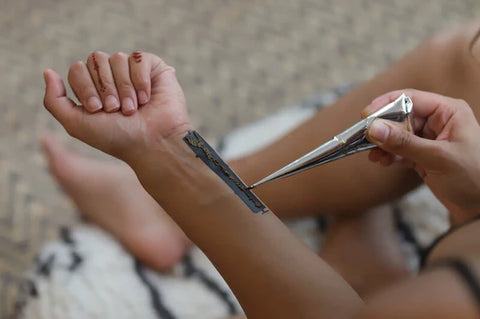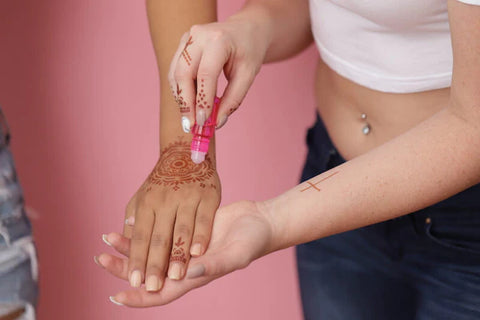You got questions, we got answers. If you’ve been wondering about henna, then you’ve come to the right place. Our body art experts at Mihenna unveil the truth about about henna.
Is Henna Safe?
This frequently asked question is more complex than it seems due to misconceptions about henna. Let’s break it down into a few different areas - pure henna, brown henna paste, and black henna.
- Pure henna a dye is made from the leaves of the Lawsonia inermis plant. The leaves are dried and crushed into a powder. The henna plant has a very low potential for skin allergies, according to the Dermatology Online Journal. However, this powder isn’t going to stick to your skin or create beautiful designs.
- Brown henna paste is made by mixing the powder with at least one type of liquid in order to make it adhere to your skin. Most reactions are due to these additional ingredients. It’s important to read the ingredients and test the henna paste in a small area if you have sensitive skin.
- Black henna is a misnomer and does not actually contain any powder from the Lawsonia inermis plant. It often contains p-phenylenediamine (PPD), also known as coal tar. PPD is considered a contact allergen and has a long list of symptoms you can read more about on DermNet. Black henna is not common in the US, Canada, or the UK, but it can be found abroad. Be sure to only get henna tattoos when the paste is brown or reddish-brown, earthy color.
At Mihenna, our organic henna paste is made from high-quality Lawsonia inermis powder, water, eucalyptus oil, cane sugar, and guar gum. While it is unlikely that the majority of people would have any skin reaction, please test on a small patch if you have frequent skin sensitivity or irritation.
But even natural henna paste should not be consumed. If you, your child, or your pet ingests henna paste, you will likely have an upset stomach and experience diuretic effects.
Who Invented Henna?
Lawsonia inermis, the plant that creates henna, grows in northern Africa and also western and southern Asia. Cultures in Africa - especially Morocco, the Middle East, Pakistan, and India all developed uses for this plant. From medicines made out of the roots to dye for hair and skin made out of the dried, powdered leaves, Lawsonia inermis rose in popularity. Different traditions developed in these regions, but almost everyone ended up using the dye to stain designs on their hands. Henna tattoos have distinct motifs based on where they originated. Read more about the history of henna in our previous posts.
Does Henna Expire?

Henna paste will become less effective over time, especially when stored at room temperature. The stain won’t be as dark, and ingredients may separate depending on what the henna is made out of. Fortunately, there is no health hazard or danger related to expired henna. You can easily extend the life of your henna paste by storing it in the freezer for up to 3 months.
How Long Do Henna Tattoos Last?

Henna tattoos can last between 1 and 3 weeks, depending on how well you care for them. Because henna is a dye that absorbs into your skin cells, the faster you lose skin cells, the faster your henna stain will disappear. We’ve got some tips to make it last.
- Before you get your henna paste applied, exfoliate. Get off as much dead skin from the area as you can.
- Wash the area to remove your natural oils, and then fully dry your skin.
- Avoid water for the first few hours. Don’t jump in the shower right after you get your tattoo.
- After you have your gorgeous henna, do not exfoliate! Your dead skin cells will naturally fall off, but try to avoid encouraging them.
- Moisturize the area to keep your skin healthier for longer. We recommend using coconut oil to keep the area luscious.
Can I Create Beautiful Henna Tattoos If I’m Just A Beginner?

We’re so glad you asked! Even beginner henna artists can create stunning temporary tattoos with Mihenna sticker stencils. We have a variety of designs for you that you can even mix and match to create a whole new look. The stencil’s adhesive backing holds the pattern in place as you apply henna paste over the top. Once it’s dried, you peel off the stencil to reveal a flawless henna tattoo. There’s no smudges. No mistakes. No “Oops, I meant to make counter-clockwise swirls.” No “I haven’t really thought this design through.” Just a beautiful work of art you created yourself. Try one today!

1 comment
Ty for the tips!